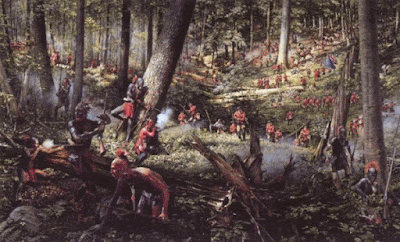A Prequel
This is a rare Yankee Doodle Spies "prequel" post. In many ways, the seeds of the American struggle for independence were watered with the blood of the French and Indian War. And in a bold coincidence, George Washington's activities in the western (Virginia- Pennsylvania-Ohio) frontier played a role in its beginning. A young Washington had explored the frontier for the then Governor of Virginia, Robert Dinwiddie. During one mission, an altercation with a party of French and Indians spurred both nations (and much of Europe) into a long and costly war. As one of the few English who had traversed the wilderness, Washington was appointed a special aide to the commander in chief of British forces in North America, Edward Braddock. Washington did not have a Royal commission, however, and was considered a colonial officer. This was no small factor in Washington's later drift from being English to being American.
 |
| Washington became a special assistant due to his experience in the west |
The Campaign
 |
| Gen Braddock |
 |
| The Western Theater of Operations |
The Road to Victory
 |
| Sketch of Braddock's Route |
 |
| The thickly forested Allegheny Mountains would prove a formidable obstacle fro Braddock's column |
The Road to Destruction
On 9 July 1755, Braddock's force crossed the Monongahela River west of a place called Turtle Creek. Braddock's advance guard of 300 grenadiers and colonials with two cannons under Lieutenant Colonel Thomas Gage (later of Boston infamy) began to move ahead. Washington tried to warn him of the flaws in his plan but Gage ignored him. Confident there was no enemy about, they moved out in column along a narrow path under the heavy wooded canopy. Then unexpectedly, Gage's advance guard came upon the French and Indians, who were hurrying to stop the British at the river. But behind schedule and too late to set an ambush, they ran head-on into Gage's men. The enemy forces were led by a French Captain named Beaujeu, who fell mortally wounded at the opening of the engagement. The surprise of two forces colliding into each other initially surprised both sides. But the French and Indians rallied quickly and began to pour a murderous fire into the British column. After an exchange of fire, Gage's men fell back. In the narrow confines of the road, they collided with the main body of Braddock's force, which had advanced rapidly when the shots were heard. The entire column dissolved in disorder as the Canadian militiamen and Indians enveloped them and continued to snipe at the British flanks from the woods on the sides of the road. Musket balls buzzed through the woods, striking tree limbs with a crack and leaves with a zing. But it was the silent rounds that struck man after man. War cries and death from behind the dense undergrowth took also its toll on the British, as did the heat. Then the French regulars began advancing along the road and began to push the British back. The British organized defense collapsed.
 |
| Indians ambush the British column |
Despite deadly bullets from seemingly all directions, the British officers tried to rally the men. The British also tried to employ some of their cannon. But again the narrow confines prevented effective use. The colonial militias and troops rallied and engaged the Indians with aimed fire. But some of them received "friendly fire" from panicked British regulars, still attempting to maintain their formations. The fighting lasted several hours. Washington was all over the place, trying to take charge where he could. He rallied small parties and, when Braddock was shot from his horse, he established a rearguard and ensured the wounded commander reached safety. Many other officers died trying to rally and lead their men. The Indians did a good job of picking off the officers, who suffered an extremely high proportion of casualties. Washington himself had two horses shot out from under him and bullets pierced his clothes, but he came out with not one scratch on him. By sunset, the surviving British and colonial forces were fleeing back down the road they had built.
 |
| Gen Braddock falls wounded |
The Aftermath
The French won this battle (usually called the Battle of the Monongahela) and suffered 40 casualties - less than 10 percent. The British suffered almost 900 - more than 60 percent. Braddock himself succumbed to his wounds on 13 July. The next day, Washington buried him under the road near the head of the column. The site for his burial was chosen to prevent the French and Indians from desecrating his grave. The outnumbered French did not follow up with a pursuit of the British and the Indians began looting and scalping. These two factors saved the column form further destruction. Hope of a quick British offensive towards the Ohio was decisively crushed on the road of destruction. They would not be revived until three years later, ironically, by use of the northern approach and what became Forbes Road.
